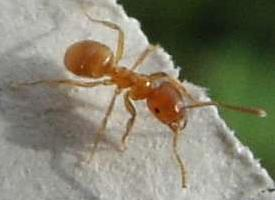
Stav ohrožení
| Ohrožen |
Popis zvířete
The Yellow Meadow Ant, scientifically known as Lasius flavus, is a small yet intriguing insect that plays a vital role in the ecosystems it inhabits. This species is a member of the Formicidae family, which is a diverse group of ants found worldwide. The Yellow Meadow Ant is primarily distributed across Europe, but it can also be found in parts of North America and Asia, thriving in temperate climates.One of the most distinctive features of Lasius flavus is its coloration. As the name suggests, these ants exhibit a yellowish or yellow-brown hue, which can range from light lemon to a more golden brown. This coloration helps them blend into their meadow environments, providing a degree of camouflage against predators. The workers, which are the most commonly seen caste, are typically about 2 to 4 millimeters in length, making them relatively small compared to some other ant species.
The Yellow Meadow Ant is a ground-dwelling species, preferring to construct its nests in well-drained, open grasslands, hence the "meadow" in its common name. The nests are typically not visible from the surface as they do not create large mounds of earth like some other ant species. Instead, their nests are often indicated by small entrances in the ground, which can be surrounded by tiny piles of soil ejected as the ants excavate their subterranean chambers and tunnels.
The social structure of Lasius flavus colonies is fascinating. A single colony can contain thousands of individuals, organized into a strict hierarchy. At the top is the queen, whose primary role is to lay eggs and ensure the continuation of the colony. She is larger than the workers and can live for many years, often over a decade. The workers are sterile females that perform various tasks, such as foraging for food, caring for the young, and maintaining the nest. Males are produced solely for reproductive purposes and have a short lifespan.
Yellow Meadow Ants are omnivorous, feeding on a variety of substances. They have a particular affinity for the honeydew produced by aphids, which they actively farm and protect in a mutualistic relationship. The ants also consume small insects and other arthropods, as well as plant material. During the summer months, the workers can be seen foraging for food to support their growing colony.
Reproduction in Lasius flavus colonies occurs when new queens and males take flight in a nuptial flight, typically during warm, humid days in late summer. After mating, the males die, and the fertilized queens land, shed their wings, and search for a suitable location to start a new colony.
An interesting ecological aspect of the Yellow Meadow Ant is its role in soil aeration and nutrient cycling. As they dig their intricate tunnels, they help to aerate the soil, which can improve water infiltration and root growth for plants. Their waste products also contribute to the nutrient content of the soil, benefiting the surrounding vegetation.
In summary, the Yellow Meadow Ant is a small, yellowish ant species that forms complex social colonies in meadow ecosystems. Their nests are underground, and they exhibit a mutualistic relationship with aphids. These ants play a significant role in the environment by contributing to soil health and supporting plant growth. Despite their small size, Yellow Meadow Ants are a vital component of the biodiversity in the habitats they occupy.
Podobná zvířata
Nové fotografie zvířat
Top 10 zvířat
- Dolphin gull (Leucophaeus scoresbii)
- Diana monkey (Cercopithecus diana)
- Moustached guenon (Cercopithecus cephus)
- Galápagos tortoise (Geochelone nigra complex)
- Russian tortoise (Testudo horsfieldii)
- Japanese macaque (Macaca fuscata)
- Greek tortoise (Testudo graeca)
- Stone loach (Barbatula barbatula)
- Common flying dragon (Draco volans)
- Colossal squid (Mesonychoteuthis hamiltoni)


